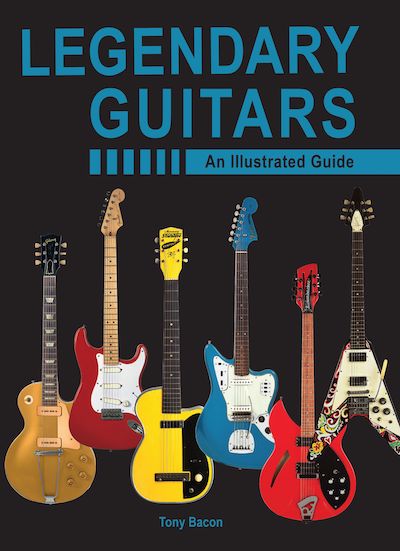
288 pages, 20cm x 28cm
2020, Chartwell
Legendary Guitars: An Illustrated Guide
My idea for this began with a timeline of as many mid-century guitars introduced between 1950 and 1969 that I could fit comfortably within such a book’s pages. From there, I thought I’d branch off to show how these instruments have influenced the design, the looks, and the playability of more recent electric guitars, right up to those of today.
I intended to call the book Electric Guitar Evolution, which seems to convey what it’s about, but the US publisher felt that Legendary Guitars was better. So, Legendary it was, and Legendary it is.
The result is a sweeping voyage through some of the best known guitars ever—nearly all the Teles and Lesters and Strats and 335s and so on you could want—alongside some of the significant also-rans from the period, which range from Ampeg to Yamaha and from Danelectro to Teisco, with much, much more between and around all those.
Inside the book, you’ll find the guitars, the styles, and the developments that made these instruments drive classic rock’n’roll, jazz, blues, country, and more. And alongside those originals are some choice examples of more recent instruments, to show how today’s makers produce fresh interpretations that draw on the 50s and 60s templates. That means everything from accurate (and pricey) vintage remakes and artist models through to the broader influences and mashup qualities of modern retro creations.
I put together the biggest collection of memorabilia ever included in one of my books, so you’ll be pleased to know there’s a heap of tasty catalogue pages, period ads, and other paper-based goodies that I figured would help convey the vibe of the different eras on display throughout Legendary. And each year from 1950 to 1969 starts with a simple spread that highlights key events from world news, aiming to give context for the instruments that follow, with illustrations that shed light on the design trends of the times—often reflected in the guitars themselves.
Anyway, I’ll finish here with three quotes from my interview archive that I put on the back of the book:
“Finding ways to use the same guitar that people have been using for 50 years, to make sounds no one has heard before, is truly what gets me off.” —Jeff Beck
“You can give somebody my brown Princeton and a ’59 Burst and a curly cable, and they’re going to make it sound like them. You can give me their Epiphone and a Line 6, and I’ll twist the knobs and eventually sound somewhat like me. It’s still all about someone’s fingers on a fretboard.” —Joe Bonamassa
“We’re always talking about Gibsons and Fenders and so on, but I really love cheap guitars, too. I grew up with all of them around—Hofner, Futurama, Burns, Watkins, Harmony. So I have great affection for extremely tacky and cheap guitars as well as the beautiful ones.” —Mark Knopfler
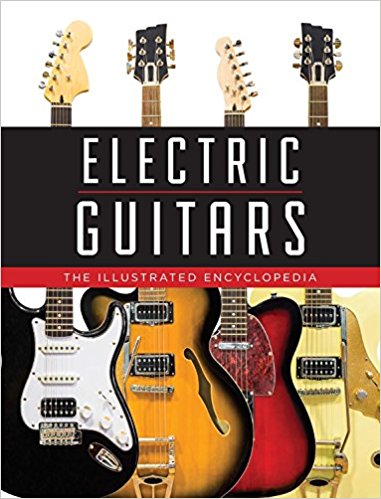
320 pages, 25cm x 33cm
2018, Chartwell
Electric Guitars: The Illustrated Encyclopedia
A massive job, this one. It’s an encyclopedia that covers … wait a minute while I count … 130 brands of electric guitars, from Acoustic (yes, this book on electric guitars starts with the Acoustic brand) to Zemaitis. Major brands get the full treatment, of course, with quite a few at some length, while the smaller brands are necessarily shorter.
To see a list of all the brands covered in the book, click the link here.
We published the original edition – see its jacket below here – back in 2000. In 2018, we revised and updated the book for a new edition, published by Chartwell, and that’s the jacket you can see on the left.
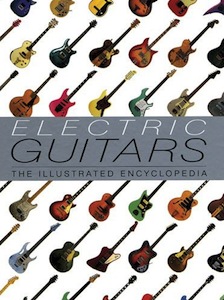
Just now, as I opened my original copy of the book to count the number of brands inside, an old press release floated out. It has some further mind-numbing statistics that I know you’ll want to hear: 320 pages, over 1,200 photographs, including 750 classic and rare instruments and 450 players, original ads, and memorabilia. There’s also a 12-page bit at the front rounding up the pre-history of the guitar before anyone thought about plugging it in.
That press release goes on to say: “Arranged as a comprehensive and informative A-to-Z of guitar brands, written by the world’s leading authorities on the subject.”
Those “leading authorities” … that means me and a trio of hard-pressed helpers: Dave Burrluck, Paul Day, and Michael Wright. We did well, actually. It’s a big book overflowing with informative and entertaining stuff, and I’m proud of it. As the great Paddy McAloon of Prefab Sprout put it in his song of the same name: “Grander than castles, cathedrals, or stars – Electric Guitars!”

176 pages, 21.5cm x 28cm
2017, Backbeat
Electric Guitars: Design & Invention
I’m intrigued by simplicity. And I’m intrigued by the way the best designers often aim for simplicity … and how that can be the hardest thing to do. For me, it applies to guitars, it applies to architecture, it applies to cooking, it applies to a lot of the things I love. So I wrote a book about the first one of those, and here it is. It covers the story of electric guitar design from the instrument’s birth in the 20s and 30s to the crowded scene today.
I’ve dug down deep into my research files and looked around at where we are now. I’ve tried to get to many of the interesting bits of guitar design by considering not only the obvious headline instruments – the Telecaster, the Les Paul, the Rick twelve, the Flying V, and so on – but also some of the whackier guitars by people like Antonio Wandrè Pioli in the 60s. I’ve taken on board later developments such as the 80s superstrat by Kramer, Jackson, Ibanez, and others, and I’ve moved the story on to today, among other things dissecting the continuing vogue for vintage reissues and aged relic’d guitars. What I’m aiming for is a new way of looking at electric guitar history.
The book includes interviews with designers and makers old and new, with selections from my archive of interviews alongside a series of new chats with Ken Parker, Paul Reed Smith, Grover Jackson, Jol Dantzig, Ulrich Teuffel, Pete Malinoski, and Dennis Fano.
You can read an extract from the interview I did for the book with Ken Parker by clicking here.
Click here for an extract from the book posted at Reverb.com and which covers Teuffel guitars.
And click here for an interview that guitarfactorytours.com did with me about matters around and about the book.
Electric guitars have never come about by chance. They look and sound and play the way they do by design. And the people who design today’s guitars draw regularly from the treasury of great instruments created in the 50s and 60s. In this book, I’ve tried to show how those masterpieces happened, why they’re still important, and the effect they have on modern guitar design. Just what does it take to develop and create a classic electric design suitable for the bedroom hopeful or the world-beating rock star?
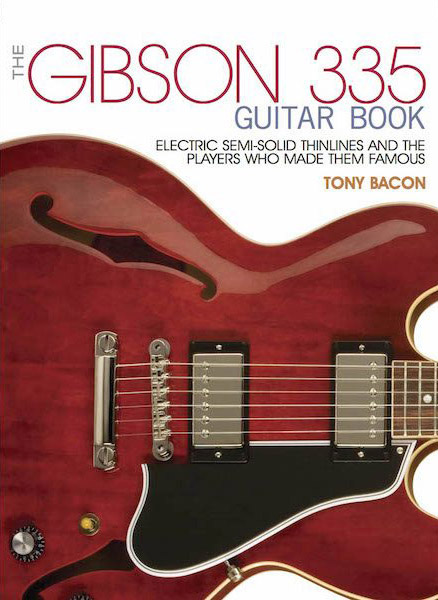
160 pages, 21.5cm x 28cm
2016, Backbeat
The Gibson 335 Guitar Book
This is a book I’ve been thinking about for a long time – and I kept putting it off because I knew it was going to be tricky. But I’m really pleased I finally got around to it, because it turned out to be a joy to research and write.
Of course it covers the 335, but there’s also the stereo 345, the upscale 355, and the hollow 330, and I sorted out and found stories about the dozens of related models introduced during the six decades that followed the 335’s introduction in 1958.
I did my usual thorough round of background chats with plenty of Gibson people, and the book has interviews with and stories about all the major 335-family players, including Eric Clapton, Dave Edmunds, Dave Grohl, Grant Green, Justin Hayward, Jorma Kaukonen, B.B. King, Alex Lifeson, Bill Nelson, Eddie Phillips, Lee Ritenour, Emily Remler, Howard Roberts, Andy Summers, and more.
I’ve made an extract from the chat I had for the book with Larry Carlton, available for anyone to read – just so long as you can manage to click on the link here.
One online reviewer who gave the book five stars wrote: “Your books keep getting better!” That was so good to hear. And you know what? I tend to agree.
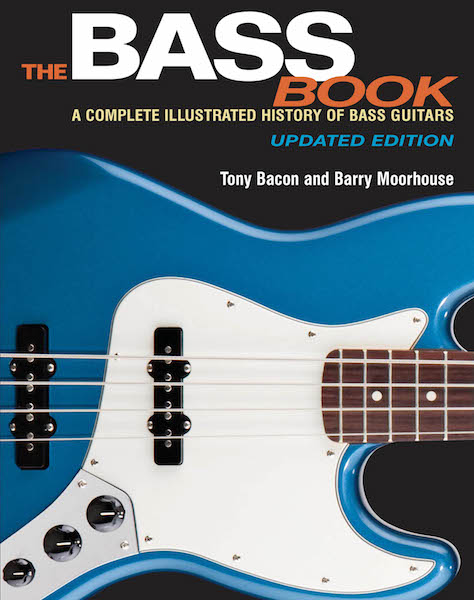
176 pages, 21.5cm x 28cm
2016, Backbeat
The Bass Book
As a one-time bass player, I’d always wanted to produce a book that told the story of the electric bass guitar. I’d known Barry Moorhouse for some time, and his fantastic Bass Centre store was based at the time in Docklands, east London. He was the obvious person to hook up with on this one: Barry is a lovely bloke, and he knows everyone. We had a lot of fun making this book.
The first edition appeared in 1995, and the jacket was in the style of our existing guitar books (pictured below left), and then a second edition came out in 2008 (jacket below right) in our larger, softback format.
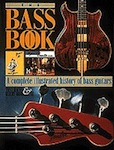
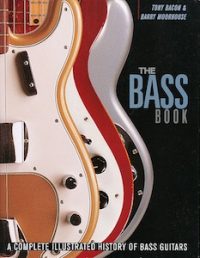
The icing on the cake came when Paul McCartney agreed to be interviewed for the book. I believe Mr McCartney got out of the right side of the bed the morning my fax arrived asking for an interview. I remain very grateful for his bedroom arrangements.
Click here to read an extract from the interview with Paul McCartney.
Suffice to say, Barry and I were proud to be the first to tell the story of the introduction and development of the electric bass in a book dedicated to the subject.
There’s an interview here that Bass Musician magazine did with Barry and me about the book.
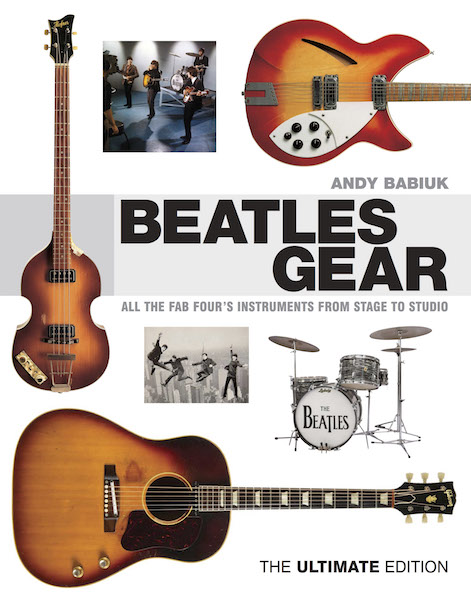
512 pages, 25cm x 32.5cm
2015, Backbeat
Beatles Gear
This is a book by Andy Babiuk that I was deeply involved in, both as its editor and publisher. I first met Andy back in the 90s when I needed help with the short chapter I wrote about Beatle guitars in Classic Guitars Of The 60s (see Fuzz & Feedback here).
We got on well and revelled in a common love of all things Beatle, but especially the instruments the group used. Andy told me then about the ambitious project he’d started, a book that would cover the entire story of the guitars, drums, amps, keyboards, and anything else the group got a sound from.
We ended up contracting to publish Andy’s book. I edited it, and in 2001 it appeared at last: the first edition of Beatles Gear. It was a hardback and the front looked like this:
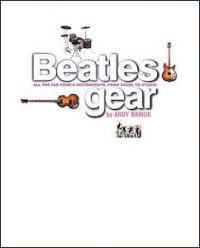
Andy had put together something remarkable. What I particularly liked about his approach was that, as a working musician, he was realistic about how The Beatles had dealt with the gear available to them. He was enough of a fan to want to know all the intimate details, but he was clear-sighted enough to know that what really happened was often an oddball mixture of chance, opportunity, and happenstance. I enjoyed working with him. We had good fun with the back and forth of picture selection and text refinement, and we did quite a few photography trips together.
Anyway, we published the book; we were all very proud of this fantastic piece of work; and soon it became a hit. There have been a few re-makes since that first edition, all of which I again edited. The first appeared hard on the heels of the first, in 2002, and was a paperback version with some useful additions and revisions (jacket below left). The next version appeared in 2009 (jacket below right) and had some small revisions. The biggest change came with the Ultimate Edition, the one pictured top left: it came out in 2015 and has many, many more pictures, some new text, and a number of revisions.
If you’d like to read my foreword to the Ultimate Edition, you could do a lot worse than clicking the link here.
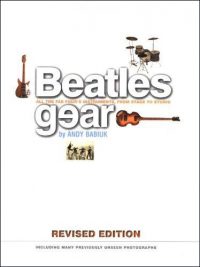
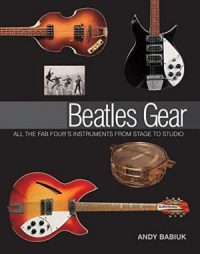
I was pleased to have the great Beatle authority Mark Lewisohn write us a foreword in 2001 for the first edition of Beatles Gear, and I’ll finish with some suitable lines from that. “Facts, mundanely reported, can become very boring very quickly; discernibly interpreted and imaginatively presented, however, they can tell a strong story,” Mark wrote. “Andy Babiuk shows himself to be both a persistent researcher and a writer of clarity. The result is a book about a narrow path that permits a broader vista, offering another glimpse, in its way significant, into the Beatles mechanism – that once-in-several-lifetimes combination of hubris, chutzpah, and a musical invention literally unparalleled in the modern era.”
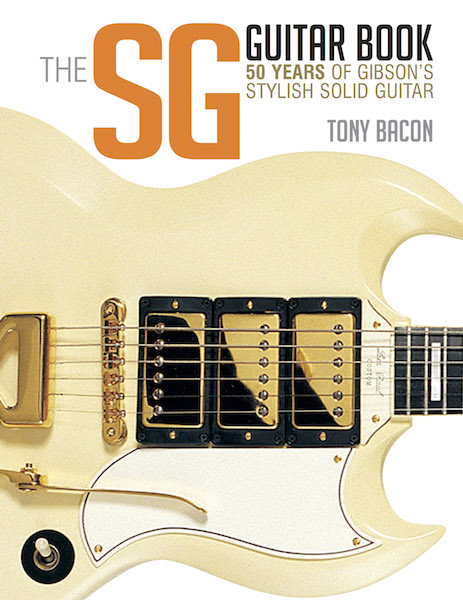
136 pages, 21.5cm x 28cm
2015, Backbeat
The SG Guitar Book
I’ve written quite a few books about Les Pauls, so why not one about SGs? Answer: here it is. Curious, really, how overlooked the SG can be in some quarters. What a great design! It was supposed to replace the original single-cutaway Les Pauls, at least in Gibson’s view during the early 60s. Presumably they’re quite pleased these days that the result was two classics instead of one. Gibson described the SG as an “ultra thin, hand contoured, double cutaway body”. The modernistic mix of bevels and points and angles was a radical departure, and I’ve told the story here of all the SG models that followed and the success of this sometimes overlooked and underrated guitar.
There are interviews with and stories about Gibson personnel through the years and all the major SG players, including Pete Townshend, Frank Zappa, Tony Iommi, Eric Clapton, Angus Young, George Harrison, Tony McPhee, Barry Melton, and Derek Trucks.
If you click on the link here you’ll find an extract from the interview I did for the book with Tony Iommi.
I’ve covered all the classic Standards, Specials, Juniors, double-necks, Customs, and TVs, and also the lesser-known SGs, such as the Tributes, the Deluxe, the Supreme, and the Diablo, as well as related guitars like the Melody Maker and signature models for guitarists from Robby Krieger to Jimmy Page. The reference section alone should keep SG trainspotters happy for months.
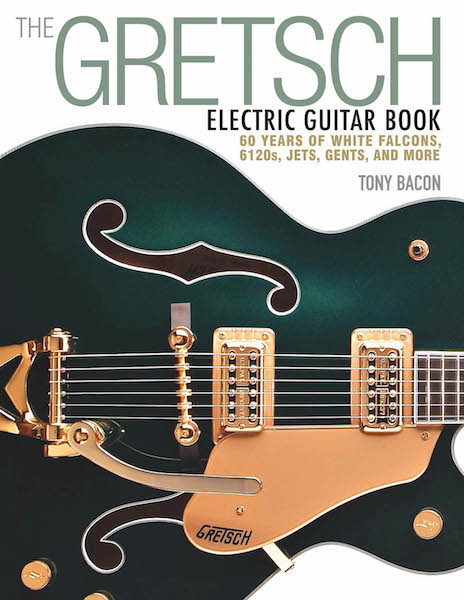
160 pages, 21.5cm x 28cm
2015, Backbeat
The Gretsch Electric Guitar Book
I’ve been improving and updating my work on Gretsch for some time. This is the third edition, in effect, of something that started with The Gretsch Book in 1996 (below left), became 50 Years Of Gretsch Electrics in 2005 (below right), and culminated in what I’d like to think is the best version yet as The Gretsch Electric Guitar Book in 2015.
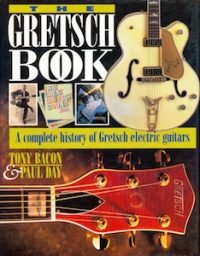
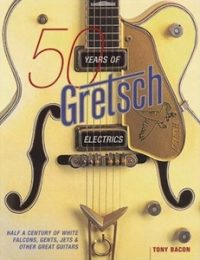
What’s changed over those years? Well, I’ve dug deeper into the story by refining my research, I’ve widened the range of voices to amplify that story through more interviews with Gretsch workers and with Gretsch musicians, and I’ve improved the accuracy of and the period covered by the reference section.
As an example of the players represented in the book, you can read part of the interview I did for the original edition with Chet Atkins by clicking the link here.
This latest Gretsch book of mine fits into the established three-part style of our guitar profiles series. I’ll quote what I said on the jacket rear: “First, there’s a compendium of cool photos that adds up to a must-have Gretsch collection. Second, there’s an absorbing tale that takes you from the introduction of Gretsch’s first proper electrics, on to the famous Chet Atkins models and the White Falcon, and through to the recent guitars and the Fender era. Third, there’s a useful guide with all the info a collector might want on original models, reissues, new guitars, artist models, serial numbers, and more.”

192 pages, 28cm x 28cm
2014, earBOOKS
The Guitar Collection
Something a bit different this time. Earbooks, a German publisher of stylish music books, asked me to put together a tome that covered the whole history of guitars and guitar playing. Oh, is that all? Well, I don’t often do work for outside publishers, as we always seem to have enough to fill eight days a week with our own projects. But this seemed like a good one to have a shot at – and, to be honest, what swung it was that I liked the people at Earbooks and their approach.
What we ended up with is a different slant and a handsome chunk of a book. It’s in a big hardback format, and the inside is divided into Flattops, Hollowbodys, and Solidbodys, along with a couple of nice design touches: first, an illustrated guitar index; second, a swathe of sleeves for over 100 recommended guitar albums.
If you click on the link here, you can see (and argue with) the full list of those fancied guitar albums.
The multilingual among you might also like to know that the book comes with English and German text alongside each other. Und das ist without doubt gut, however you look at it.
Earbooks managed to conjure a keen slice of vinyl to tuck into the back of the book: a rare version of ‘Smoke On The Water’ by RockAid Armenia, which included Brian May, David Gilmour, Ritchie Blackmore, Tony Iommi, and Alex Lifeson, so that seemed like a bonus.
To see a short promo video click here: it features a handful of the guitars featured, with a clip of the ‘Smoke’ track playing along.
Joe Satriani wrote a foreword for me, and he said some good things. I especially liked this: “Some days we may want to go back, to reflect on the older tools, but eventually we have to use the modern tools. It’s a constant search, a continual craving for new sounds, for new techniques, for new tones and timbres. No two guitars are alike, in the same way that no two musicians are exactly the same.”
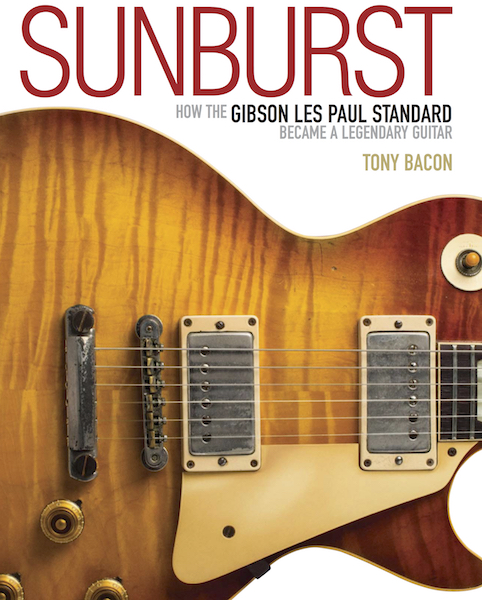
144 pages, 21.5cm x 28cm
2014, Backbeat
Sunburst
If there’s one guitar that sums up the craze for collecting, it’s the sunburst-finish Les Paul Standard made for just a few years between 1958 and 1960. This is the book where I zoom right in on that instrument.
It’s a remarkable story, and one that I first dipped into with Million Dollar Les Paul (more on that one here). Here, however, I tell the story in our familiar format: a detailed main story, interspersed with dozens of luscious pictures, and a reference section up the back with the detailed facts. It proved to be a popular combination, with some great reviews and feedback.
I did this interview with Gibson.com about the book.
I looked hard at all the key instruments in the early history, the Bursts belonging to Clapton, Page, Green, Allman, and more. I talked to players, collectors, guitar-makers, and dealers as I unravelled the myth and tried to put history into focus. The idea also was to show exactly where this guitar has ended up now, so I investigated all the reissues and special editions and signature models that have followed the originals.
Don Felder, Billy Gibbons, Joe Bonamassa, Rick Nielsen, Steve Lukather, and Keith Nelson helped me explain how the Burst fits into their musical world, and how a valuable guitar thought at one time only to inhabit bank vaults is slowly returning to its natural habitat … the rock’n’roll stage.
One important footnote: I finally got to interview Jimmy Page in August 2014 … just too late to include in this book. Damn! But here’s an extract from that interview.
